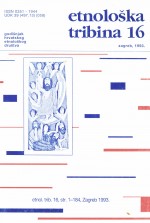Autobiografija Bartola Kašića - još jedan isusovački doprinos etnologiji
Bartol Kašić's Autobiography - Another Jesuit Contribution to Ethnology
Author(s): Jelka Vince-PalluaSubject(s): Christian Theology and Religion, Cultural history, Customs / Folklore, Cultural Anthropology / Ethnology, 17th Century, The Ottoman Empire
Published by: Hrvatsko etnološko društvo
Keywords: Bartol Kašić; autobiography; ethnology; 17th century; The Ottoman Empire;
Summary/Abstract: The author’s intention is not to consider Kašić’s philological, lexicographical and literary work, those fields in which he is best known in die scholarly world but rather to talk about Kašić and his contribution to ETHNOLOGY. Kašić’s Autobiography is an essential source of information about the everyday life of ordinary people in some of the South-Slavic regions under the Turkish domination at the beginning of the 17th Century. It reveals important evidence that represents the first, and thus the oldest written data concerning some ethnologically highly significant questions. The first goal of this paper, therefore, is to show how written sources, in our case notes taken during two canonical visitations and recorded in autobiographical form, have methodological importance for ethnological research. The second goal, outside the South-Slavic frame, is connected with Croats on Italian soil that Kašić by chance met in 1613 in the region of Irpinia in Southern Italy. Using geographical and time coordinates which were sparingly provided by Kašić and comparing them with additional folkloristic, cartographic and archive materials the author has tried to reconstruct the exact place where he met those Croats and when they came to those parts of Italy. While carrying out research in the area that Kašić mentioned, the author discovered two new sites that unambiguously reveal Croatian presence in that part of the Kingdom of Naples. Kašić’s Autobiography thus serves ethnology, a science that did not even exist at his time. Is Kašić’s contribution more significant due to the two valuable and oldest written evidence - the one about joint family in Srijem and the other about the life of Croats in Southern Italy -or because of written evidence from the beginning of the 17th Century as a whole? It is difficult to say. Certainly, Kašić’s work needs to be placed side by side with the Jesuit work that has enriched not only Croatian ethnology.
Journal: Etnološka tribina : Godišnjak Hrvatskog etnološkog društva
- Issue Year: 23/1993
- Issue No: 16
- Page Range: 35-46
- Page Count: 12
- Language: Croatian

